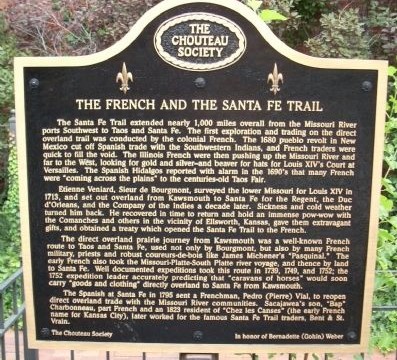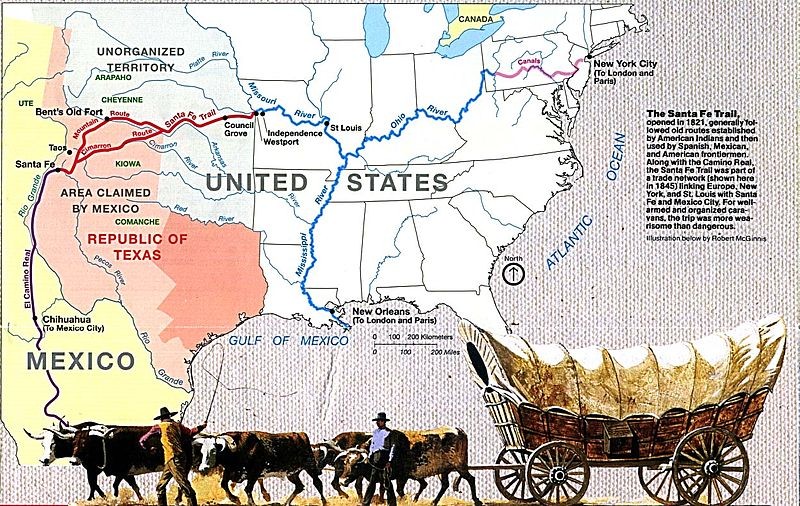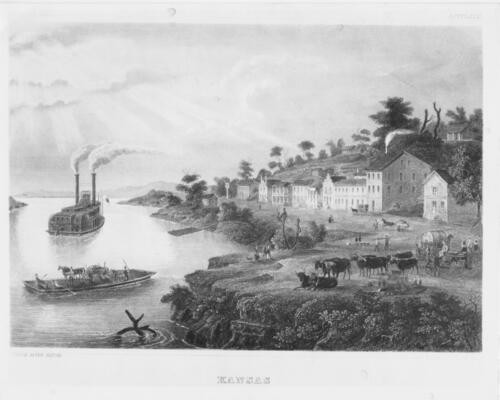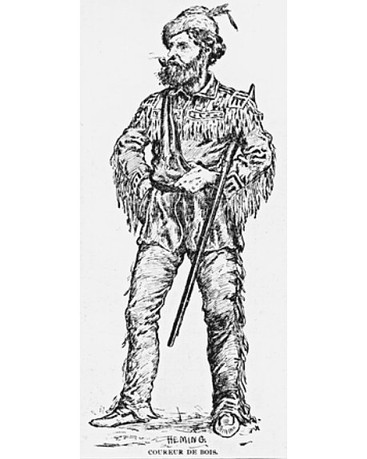The French and the Santa Fe Trail Historical Marker
Introduction
Text-to-speech Audio
The Santa Fe Trail was a land and water route between the main vein of the Mississippi River and Santa Fe, New Mexico. The original trailblazers were Frenchmen, sent from the French holding of Louisiana to establish North American trade between Spain and France. The river borne section of the trail ends at the confluence of the Missouri and Kansas Rivers, near modern day Downtown Kansas City. This marker is located in the heart of Westport, a major trading hub and disembarking point for the Santa Fe, Oregon, and California Trails.
Images
English side of the marker, courtesy of Thomas Onions

French side of the marker, courtesy of Thomas Onions

Map of the Santa Fe Trail, courtesy of Robert McGinnis

A drawing of Westport Landing at the Missouri River c.1853. Courtesy of Missouri Valley Special Collections, Kansas City Public Library, Kansas City, Missouri.

An illustration of Étienne de Veniard, Sieur de Bourgmont.

Backstory and Context
Text-to-speech Audio
By the beginning of the eighteenth century, European colonial powers had begun pressing deeper into the inland territories of North America. The route for the French was through the St. Lawrence River then down the Mississippi River and its tributaries. The French built many forts and trading posts along the rivers and dominated trade with local Native American groups. Meanwhile, the Spanish had holdings to the southwest in modern day New Mexico, expanding north from their holdings in modern day Mexico. The northernmost center of Spanish control was the settlement of Santa Fe. Since their mutual founding, the French and Spanish holdings sought a viable trade route between the two.
The French sent out several experienced explorers to try and find trade routes by several means. The former deserter and poacher Étienne de Veniard, Sieur de Bourgmont was pardoned for his crimes in 1713 and hired to chart the lower Missouri river for a land route directly to Santa Fe. Bad weather, sickness, and Native American conflicts prevented any of these early attempts at establishing a trade route from being successful. Bourgmont and other French explorers also sought a route by traveling down the Missouri River, but found they had to abandon their boats and continue southwest on foot where the Missouri and Kansas Rivers meet at Kaw Point near modern day downtown Kansas City. This route from Kaw Point eventually became the main Santa Fe Trail. Venturing across the great plains proved a treacherous endeavor, and the French had little success in reaching Santa Fe for some decades. They attempted to resolve the issue of harassment by hostile groups of Native Americans by expanding their trade networks to include more local groups along the route. Eventually, the Frenchmen were able to complete the route from Kaw Point in 1740, and a steady flow of trade between Missouri and Santa Fe began in earnest over the next two decades.
At the end of the Seven Years War in 1763, France was put into a situation where it had to sell the Missouri territories and the rest of their claims to the Mississippi River drainage basin to Spain. However, the Spanish exercised minimal control over these territories and the local Frenchmen that still lived there became the de facto powers of the region. Prominent French traders like the Chouteau family continued to control trade between the Mississippi River and Santa Fe along the trail. Traffic along the trail increased exponentially after the United States’ acquisition of the territory and it was officially opened as a trade route between the United States and Mexico in 1822.
The text of this historical marker reads as follows:
The Santa Fe Trail extended nearly 1,000 miles overall from the Missouri River ports Southwest to Taos and Santa Fe. The first exploration and trading on the direct overland trail was conducted by the colonial French. The 1680 pueblo revolt in New Mexico cut off Spanish trade with the Southwestern Indians, and French traders were quick to fill the void. The Illinois French were then pushing up the Missouri River and far to the West, looking for gold and silver - and beaver for hats for Louis XIV's Court at Versailles. The Spanish Hidalgos reported with alarm in the 1690's that many French were "coming across the plains" to the centuries-old Taos Fair.
Etienne Veniard, Sieur de Bourgmont, surveyed the lower Missouri for Louis XIV in 1713, and set out overland from Kawsmouth to Santa Fe for the Regent, the Duc d'Orleans, and the Company of the Indies a decade later. Sickness and cold weather turned him back. He recovered in time to return and hold an immense pow-wow with the Comanches and others in the vicinity of Ellsworth, Kansas, gave them extravagant gifts, and obtained a treaty which opened the Santa Fe Trail to the French.
The direct overland prairie journey from Kawsmouth was a well-known French route to Taos and Santa Fe, used not only by Bourgmont, but also by many French military, priests and robust coureurs-de-bois like James Michener's "Pasquinal." The early French also took the Missouri-Platte-South Platte river voyage, and thence by land to Santa Fe. Well documented expeditions took this route in 1739, 1749, and 1752; the 1752 expedition leader accurately predicting that "caravans of horses" would soon carry "goods and clothing" directly overland to Santa Fe from Kawsmouth.
The Spanish at Santa Fe in 1795 sent a Frenchman, Pedro (Pierre) Vial, to reopen direct overland trade with the Missouri River communities. Sacajawae's son, "Bap" Charbonneau, part French and an 1823 resident of "Chez les Canses" (the early French name for Kansas City), later worked for the famous Santa Fe Trail traders, Bent & St. Vrain.
Sources
The French and the Santa Fe Trail, The Historical Marker Database. Accessed July 28th, 2022. https://www.hmdb.org/m.asp?m=86227.
Blaine, Martha Royce. “French Efforts to Reach Santa Fe: André Fabry de La Bruyère’s Voyage up the Canadian River in 1741-1742.” Louisiana History: The Journal of the Louisiana Historical Association 20, no. 2 (1979): 133–57. http://www.jstor.org/stable/4231885.
DARY, DAVID. The Santa Fe Trail: Its History, Legends, and Lore. University Press of Kansas, 2000. http://www.jstor.org/stable/j.ctt1d391nd.
Blaine, Martha Royce. “French Efforts to Reach Santa Fe: André Fabry de La Bruyère’s Voyage up the Canadian River in 1741-1742.” Louisiana History: The Journal of the Louisiana Historical Association 20, no. 2 (1979): 133–57. http://www.jstor.org/stable/4231885.
Usner, Daniel H. “Rescuing Early America from Nationalist Narratives: An Intra-Imperial Approach to Colonial Canada and Louisiana.” Historical Reflections / Réflexions Historiques 40, no. 3 (2014): 1–19. http://www.jstor.org/stable/24720751.
Ellis, Richard N., and Charlie R. Steen. “An Indian Delegation in France, 1725.” Journal of the Illinois State Historical Society (1908-1984) 67, no. 4 (1974): 385–405. http://www.jstor.org/stable/40191318.
https://www.hmdb.org/m.asp?m=86227
https://www.hmdb.org/m.asp?m=86227
http://www.lib.utexas.edu/maps/national_parks/santa_fe_trail94.jpg
https://en.wikipedia.org/wiki/%C3%89tienne_de_Veniard,_Sieur_de_Bourgmont
